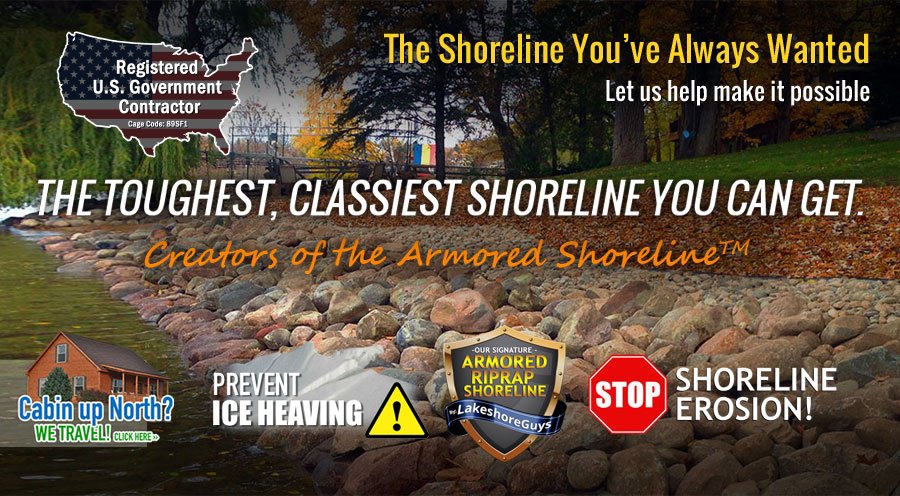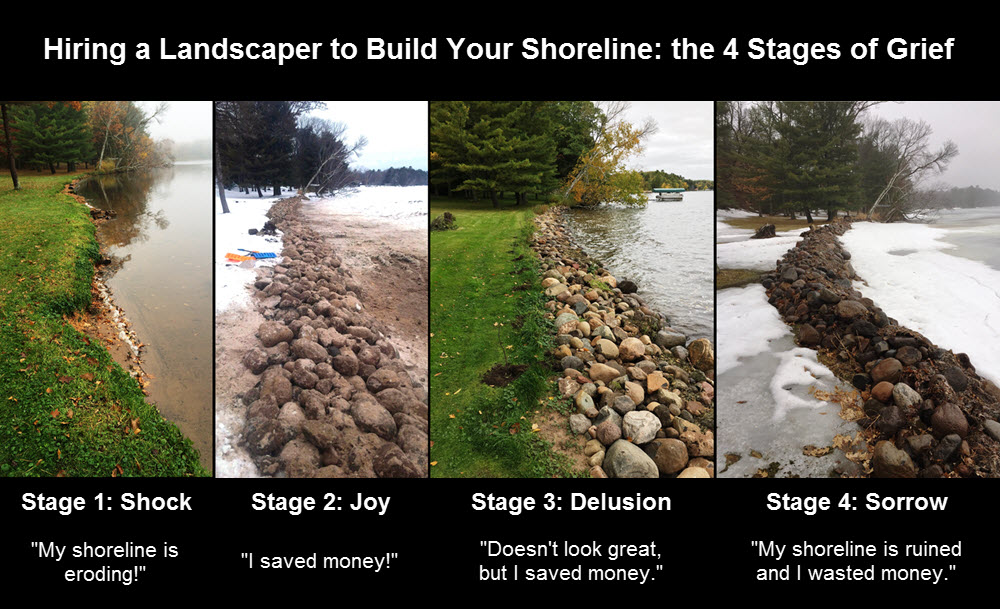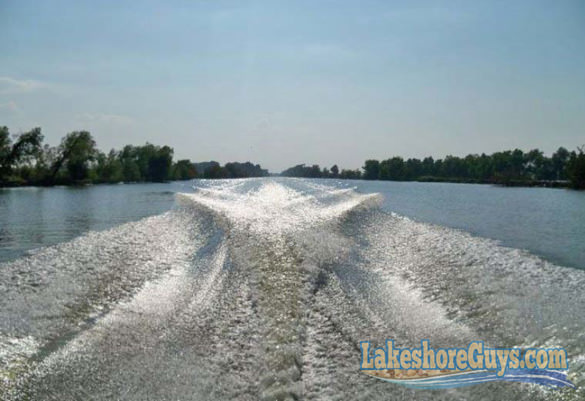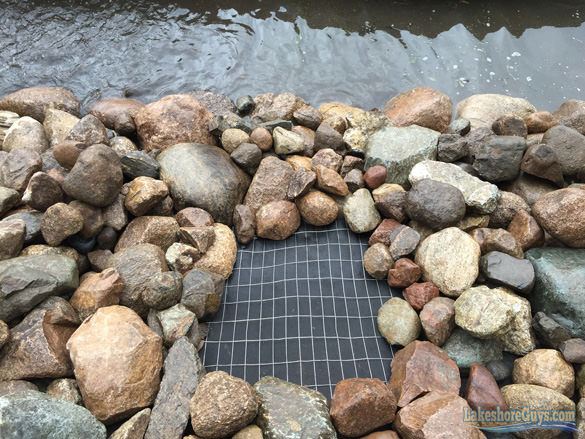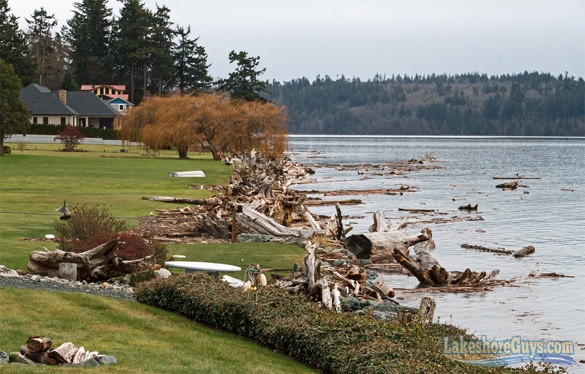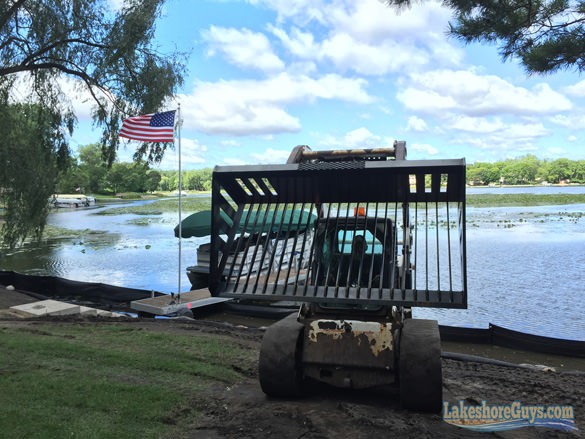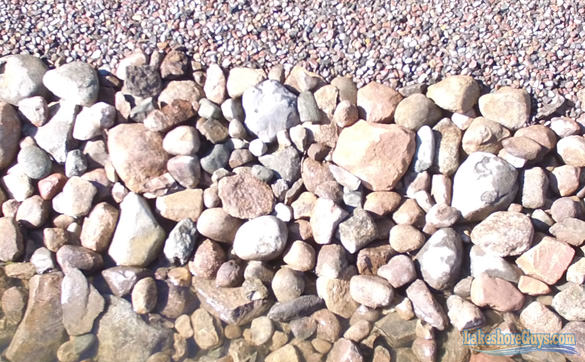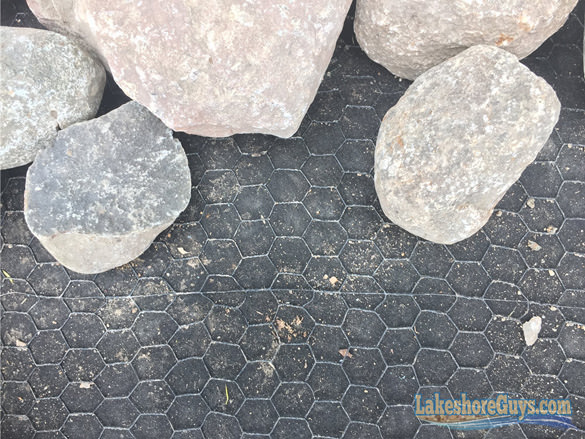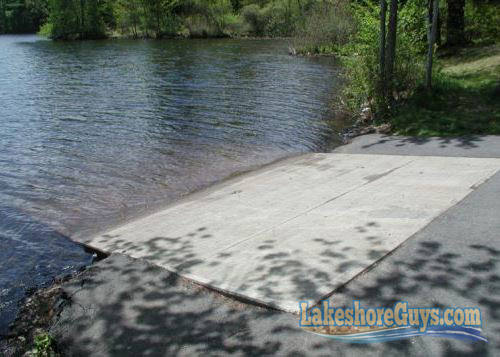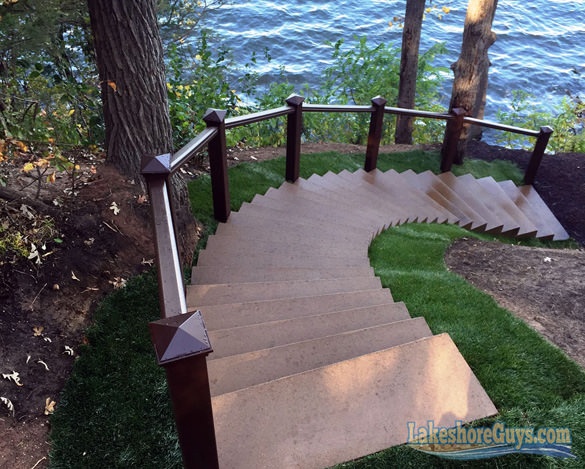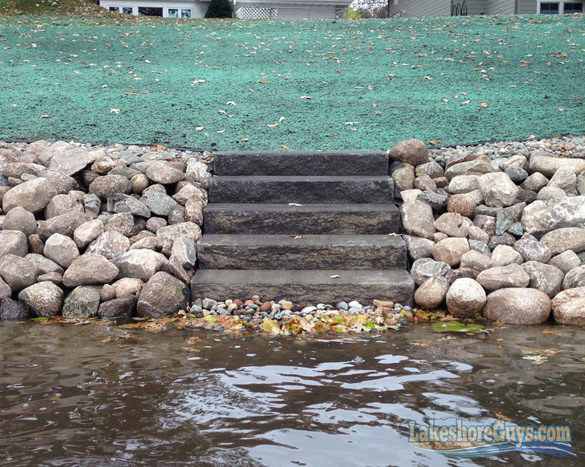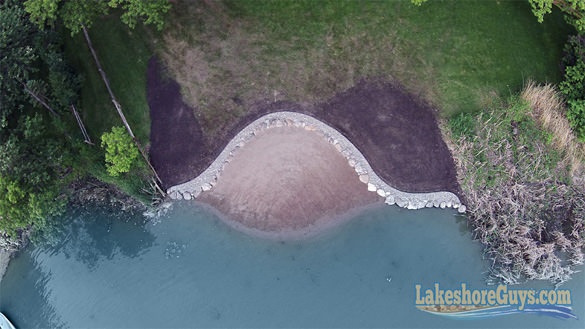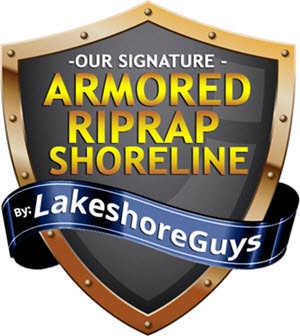
The Best Riprap Shoreline Money Can Buy: Lakeshore Guys®’ Signature Armored Shoreline. The Only Shoreline Tougher Than Nature.
The best way to end erosion, ward off muskrats, resist ice-heaving, and add beauty to your property. We travel!
Why do people from as far north as Orr, Minnesota and as far south as Branson, Missouri call Lakeshore Guys® for a better riprap shoreline?
They call for our signature Armored Shoreline. It’s the roughest, toughest, and best-looking riprap shoreline money can buy. Our photos, reviews, and this case-study should make that plain. It doesn’t hurt that we build the toughest shorelines with legendary professionalism.
“Our ragged shoreline was filled with sinkholes, overgrown weeds and we were losing our back yard by the foot. Now that Lakeshore Guys® have built our riprap shoreline it is a thing of beauty. My realtor friend told me that our property value increased significantly after their work was done.” – Karl Bradford (read full review and see Karl’s shoreline)
“We had 80+ feet of chaos (soil pushed up two feet from ice jacking, overgrown plants, trees taking over, etc.), and Lakeshore Guys® worked their magic to make our shoreline amazing….We feel as if we purchased a neighboring lot because we can’t get over how much space we can now enjoy.” – Shawn Johnson (read full review)
“The job was extensive, and expensive, but after getting other bids which didn’t itemize what would be done, and looking to preserve our shoreline for a long time we signed on. We reasoned that it was better to do the job right in the long haul and not be faced with the same situation in the short haul. We feel it was the right choice….We are completely satisfied with the result (photos enclosed). Bottom line a BIG project which was beautifully accomplished. Cheap, no, worth it absolutely!!”– Bill & Sue Carskadon (read full review and see the Carskadons’ shoreline)
How, exactly, is a Lakeshore Guys®™ Riprap Armored Shoreline better than a standard-issue riprap shoreline – like the kind peddled by landscapers and other non-specialists?
Well, besides the poor craftsmanship you’ll notice as soon as you see landscapers’ and other generalists’ work, the differences are almost too many to name. You might as well ask me to describe the differences between a Miles Davis song and a Kenny G song. But you asked, so please hang with me. You can click on one of these links to jump down to read more about a specific difference:
- Difference 1: 3:1 Slope
- Difference 2: Compaction
- Difference 3: Proper Fabric
- Difference 4: Secured Fabric
- Difference 5: Quantity of Fabric
- Difference 6: Seamless Design
- Difference 7: Critter-Proofing
- Difference 8: Fieldstone
- Difference 9: Clean Riprap
- Difference 10: Custom-Built Riprap Bucket
- Difference 11: Amount of Riprap
- Difference 12: Hand-Placed Riprap
- Difference 13: How We Transport
- Difference 14: Our Edging (optional)
- Difference 15: Frost-Break™ (optional)
- Difference 16: Our Cleanup
Armored Shoreline Difference #1: 3:1 Slope
All our riprap Armored Shorelines include proper grading and reshaping of your shoreline. Trying to achieve a 3:1 slope (or as close to a 3:1 slope as possible) is extremely important when properly restoring a shoreline. Nearly all landscapers build shorelines at the wrong slope, and nearly all of their shorelines crumble into ruin.
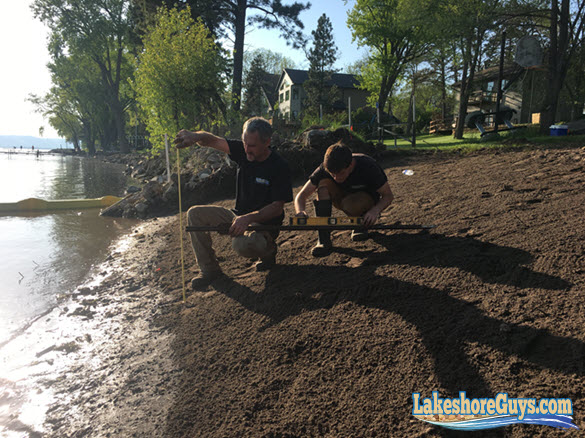
Note: Some shorelines simply don’t allow for a 3:1 slope, in which case every effort should be made to make it lower than a 2:1 slope.
There are two main reasons a shoreline should pitch at a 3:1 slope:
-
- Ice-jacking. This is the main reason. The more vertical the shoreline is, the greater the chance that the ice will jack or heave the shoreline landward during the winter months. The more horizontal or flat your shoreline is, the greater the likelihood that the ice will slide up onto your shoreline (good), rather than push against or into it (bad).
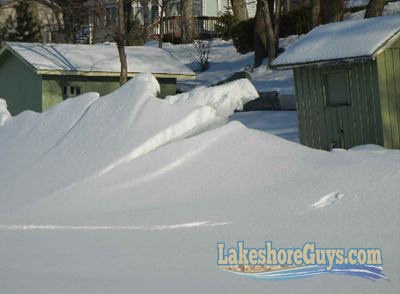
- A shoreline with a 3:1 slope is better at deflecting incoming waves than shorelines with greater or lesser slopes. The idea is to best disperse the kinetic energy of the never-ending waves pounding your shoreline.
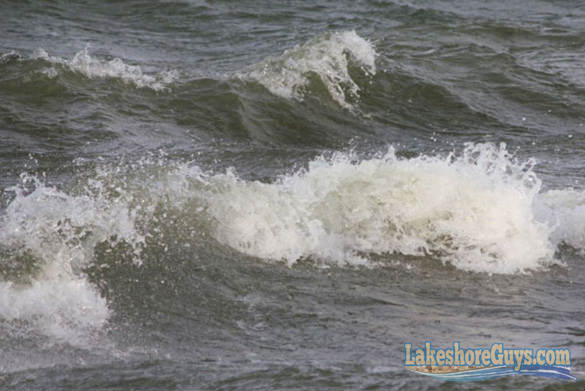
Armored Shoreline Difference #2: Compaction
By itself, even a 3:1 slope won’t help your shoreline – unless the soil is compacted properly.
If the soil is loose and airy, it will deform once you pile several tons of riprap stone on it. Though the pile of riprap may appear to have a 3:1 slope, the underlying soil may not, in which case the stones are fighting gravity. Gravity will win every time. The land under the riprap (and under the fabric) needs to maintain a 3:1 slope, both before and after the fabric and riprap are laid down.
You can’t assume a pile of dirt will be shaped exactly the same after you’ve dropped several tons of stone onto it. A true shoreline expert readies the ground for what will go on top.
That’s why we compact the soil before we install the fabric and the riprap. It’s one of the less-glamorous, more-arduous parts of the whole process. That’s one reason nobody else seems to bother. (Even other companies that specialize in shorelines seem to figure, “Well, the heavy stones will take care of the slope, right?”, and it wouldn’t even cross landscapers’ minds.)
How do we compact the soil of your shoreline, before putting down the fabric and stone?
Usually we use our backhoe bucket, by repeatedly tapping it into the ground. It does a much better job than a mechanical compactor can (we’ve tried that).
Sometimes we use the grader bar on our Bobcat. That works well also because it levels and flattens the shoreline as we compact it.
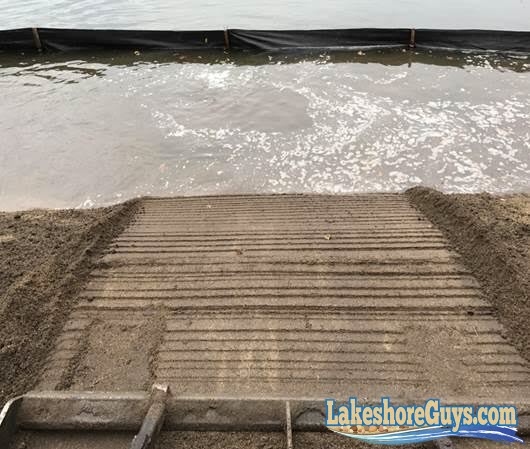
If the ground is very sandy, we pretend your shoreline is a vat of vineyard grapes, and employ the foot-stomping method. A thorough walking-over does the trick. What our pigéage method lacks in tech it makes up for in effectiveness.
Armored Shoreline Difference #3: Proper Fabric (12-oz. needle-punch filter-fabric, calendered)
We use extra-thick 12-ounce industrial needle-punch filter-fabric. Not only do we use ultra-thick, premium fabric that others don’t know about or won’t fork over for, but we also use more of it than anyone else would. The cost of our needle-punch filter-fabric is quintuple that of its 4-ounce little brother, but it’s the coin of the realm in a Lakeshore Guys® Armored Shoreline.
The fabric is so tough we often bend our staples trying to secure it to the shoreline. For every four staples we use, three will bend, and only one gets through the fabric and into the earth. We don’t mind putting the staple maker’s kids through college, because each staple that makes it through the fabric is a rivet in your armor.
We didn’t stop at having the toughest shoreline fabric on the planet, so we decided to ratchet it up a notch (a big notch!). After years of research & development we now (as of 2018) have outsourced, acquired, and use calendered fabric, which is used in NASA astronauts’ suits.
To calender or “candle” a fabric is a process of running it through hot, high-pressure rollers at the textile mill. That makes the microscopic holes even smaller, and makes the surface slicker. The big benefits of that are (1) our fabric stretches rather than breaks, and (2) it repels dirt and seeds so weeds and the like find it more difficult to take hold on your shoreline. Yet our filter-fabric is still porous enough to let water pass through it. That’s what allows your shoreline to absorb the force of waves rather than crumble in submission (the way landscapers’ shorelines do).
Ultra-tough calendered filter-fabric, pictured on the right
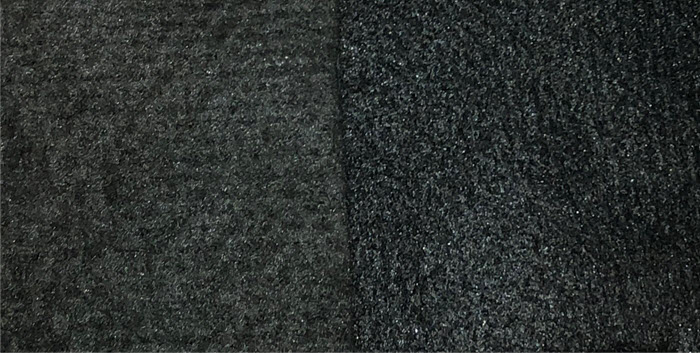
If nanotechnology takes off, we’ll be the first company to use nanobots to protect your shoreline. Until then, our custom-made, heat-treated, staple-devouring calendered fabric will buy you some extra decades.
“In three days, they removed all the rubble, built up the shore with sand, raised our lawn with dirt fill, applied a high-quality fabric, and laid down 30 tons of fieldstone with meticulous care. They even raked and seeded the dirt fill and covered it with straw to prevent washout.” – John Muellerleile (read full review and see John’s shoreline)
Armored Shoreline Difference #4: Secured Fabric
As I mentioned above, it’s important to be maddeningly thorough when stapling the fabric to the shoreline. We use four-to-six-inch steel staples to secure the fabric, prior to riprapping the shore. We do this because we know anything that helps hold this vital fabric barrier in place will help your shoreline last longer.
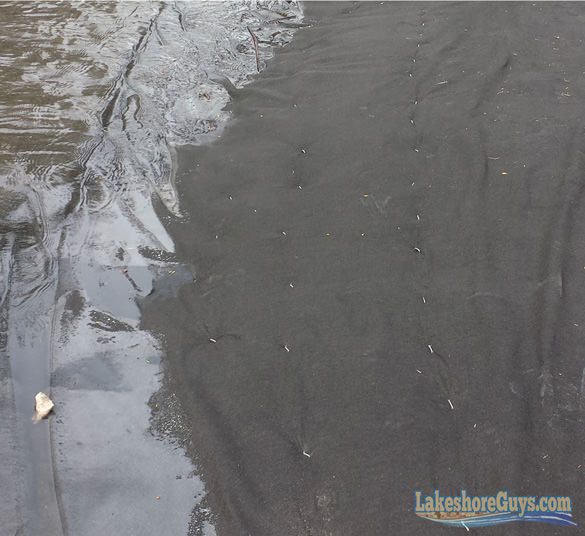
The main purpose of these staples is to prevent the fabric from shifting when we place the riprap. We take the care of an origami master to position the fabric on the shoreline, to ensure that pouring multiple tons of riprap on the fabric is an adrenaline-free event.
Note: Although these staples do breach the fabric, a high-quality filter fabric will nearly seal itself around each staple. Still, for added protection, we place a single stone directly over each staple, so that it doesn’t get clunked by a riprap stone when we pour on the mother lode.
(Can you picture your local landscaper doing that? We’ve been building shorelines for over 20 years, and took us about 10 years to figure out that little trick.)
Armored Shoreline Difference #5: Quantity of Fabric
Not only do we install the granddaddy of filter-fabric (12-ounce weight), but we install more of it than our competitors do.
That means both the landward side and the water side of the shoreline receive better coverage.
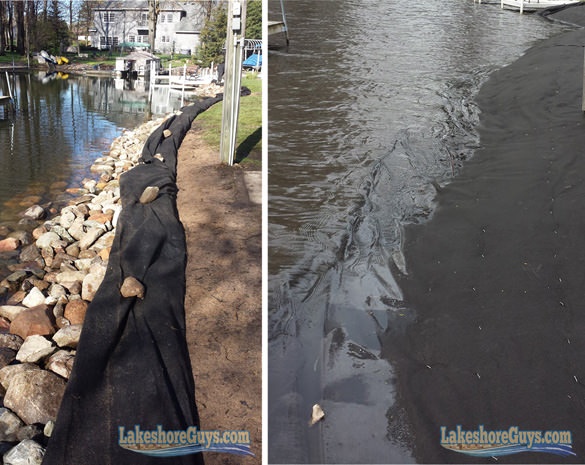
This is extremely important when trying to minimize washout – on the water side of your riprap (the “toe” of your shoreline) during periods of low water levels with strong wave-action. It also minimizes washout on the landward side of your riprap (the “heel” of your shoreline) during periods of high water levels or periods of high water levels and heavy wave action.
Remember: the main role of the fabric in your shoreline (beneath the riprap) is to prevent soil erosion. But you may be surprised to know that, aside from displacing wave energy and helping to combat ice-jacking, the main purpose of the riprap itself is merely to hold the fabric in place. Hence the reason that the type, quality, and thickness of the fabric used in your shoreline is so important. Fabric is the real backbone of your shoreline.
Armored Shoreline Difference #6: Seamless Design
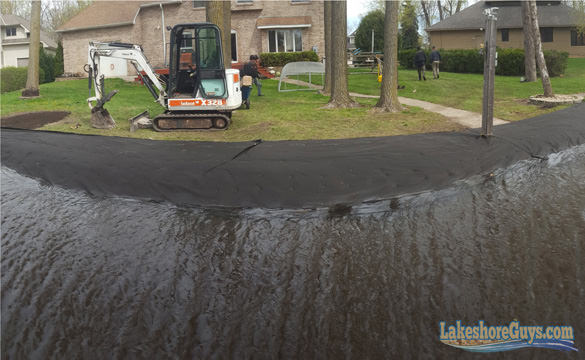
Yes, we have even more to say about the fabric part of an expertly riprapped shoreline. Even the best fabric on the planet will fail miserably if it’s seamed improperly. With a Lakeshore Guys® Armored Shoreline you won’t have to worry about seams, because in almost all cases there won’t be any. We avoid seams as a cat avoids water.
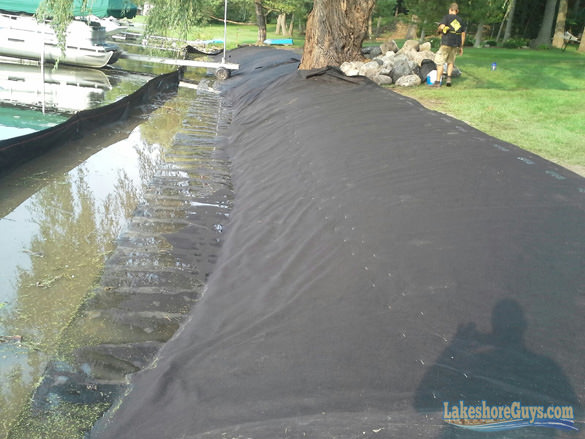
However, if a seam is absolutely necessary, then we’ll do it right. We cannot overemphasize the word “right” in this case. Assuming a seam in the fabric is unavoidable, the following steps are crucial:
- On a lake shoreline, a vertical seam must be overlapped by at least 2 feet, and it must be stapled to the ground and to the second layer of fabric beneath it thoroughly. A horizontal seam must be overlapped by at least 2 feet, stapled to the ground and to the second layer of fabric beneath it thoroughly, and be shingled in the proper direction (that is, the landward piece of fabric must cover the water-facing piece of fabric).
- On a riverbank, a vertical seam must be overlapped buy at least 3 feet, stapled to the ground and to the second layer of fabric beneath it thoroughly, and be shingled in the proper direction (an upriver piece of fabric must cover the downriver piece of fabric). A horizontal seam must be overlapped by at least 3 feet, stapled to the ground and to the second layer of fabric beneath it thoroughly, and be shingled in the proper direction (the landward piece of fabric must cover the water-facing piece of fabric).
Armored Shoreline Difference #7: Critter-Proofing
Because not everyone has issues with critters burrowing into their shoreline and raising havoc, we’ve made this an optional part of our Armored Shoreline. You can read about our critter-proofing precautions here.
“I would recommend the Lake Shore Guys to anyone looking for shoreline restoration. I had muskrats and they were very knowledgeable and worked with me to find the best solution. This company is trustworthy and does what’s in the best interest of the customer. Great experience!” – Nick Heintzelman (read full review and see Nick’s shoreline)
Armored Shoreline Difference #8: Fieldstone
Riprap comes in all shapes, sizes, and colors. With us, unless you specifically ask us to use something other than fieldstone, we’re going to use fieldstone riprap (aka river rock or glacier rock) that’s 6-12 inches or 12-18 inches in diameter. On occasion we may need larger riprap (up to 30 inches in diameter), but that’s rare.
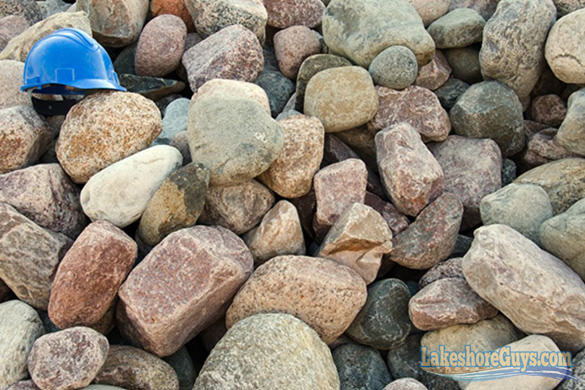

Several benefits of 6-18-inch fieldstone:
- Fieldstone is round and smooth, and rarely has jagged edges that can damage the fabric beneath during installation. Heavy wave action can also drive jagged types of riprap through even the thickest of fabrics. Round, smooth rocks seem less affected by large waves because they lack the flat spots where wave action can gain leverage and push them around your shoreline or sweep them into the lake or river. Just as a baseball is aerodynamic, a round fieldstone is aquadynamic.
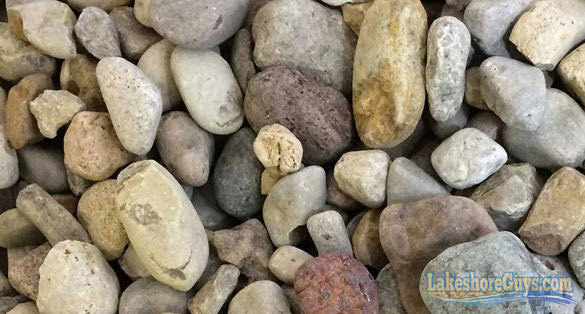
- It’s heavy. Fieldstone riprap is heavier than crushed riprap, like limestone. Heaviness is good because it keeps the underlying fabric in place. That fabric is the backbone of your riprap shoreline, and protecting it with a heavy pile fieldstone means your shoreline will last longer. (Fun fact: The blueish colored rocks in fieldstone riprap are by far the heaviest.)
- It’s colorful & attractive. Most people find the unique blend of fieldstone colors to be quite attractive. Its multicolor palette also blends well with most natural lake and river environments.
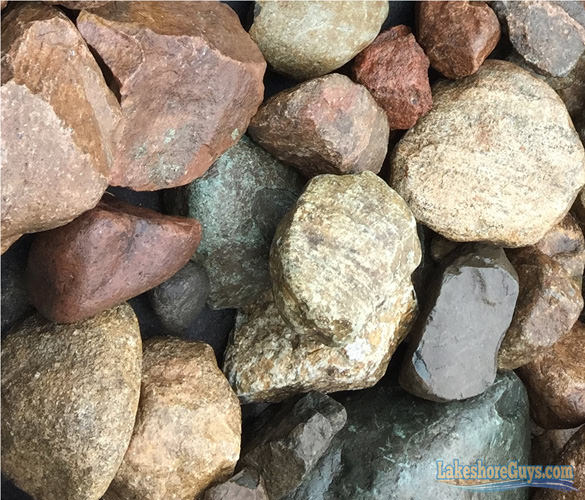
- It gathers less floating debris. Round, smooth riprap tends to catch and retain less floating flotsam – like aquatic weeds, water bottles, and anything else that may drift ashore.
Armored Shoreline Difference #9: Clean Riprap
We don’t order our riprap from a rock quarry where you end up with 15 tons of riprap and 2 tons of dirt in every truck load. Sure, that option would be cheaper for us, but we take the high road and order our riprap from a specialized company that only deals in sorted, sized, and clean riprap.
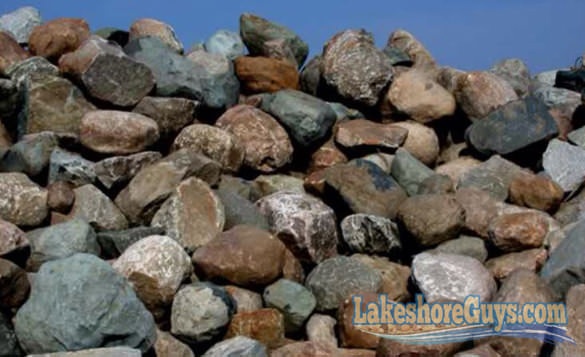
We take pains to keep your new sheet of filter fabric clean. The last thing we’ll want to do is contaminate this fabric with hundreds of pounds of soil that is mixed into the riprap. Dirt on your fabric will turn your new shoreline into a Ch-Ch-Ch-Chia Pet in a few short months.
Armored Shoreline Difference #10: Custom-Built Riprap Bucket
Ordering dirt-free riprap still doesn’t get your riprap clean enough. A Lakeshore Guys® Armored Shoreline outlasts all others partly because we get the stones as clean as a German operating room. That takes special measures.
Even the cleanest dump-truck load of riprap will have some soil in it. But it will also carry something even more concerning: rock chips.
As riprap is loaded into the dump truck you get thousands of pounds of stones that are smashing and grinding together. Fragmentation is inevitable. When small rock chips mix in with the riprap they can damage the fabric during installation. Those fragments are like hundreds of ancient obsidian arrowheads, and they will slice and dice even the toughest filter fabric.
But we came up with a solution.
We developed and built by hand our very own riprap bucket. There are plenty of “rock buckets” on the market, but none of them met our stringent standards.
Our riprap bucket keeps your new shoreline free from as much dirt and other contaminants as possible. It’s a large steel bucket with small openings in the sides and bottom of the bucket. We use this bucket to scoop up the riprap from the street (or wherever we deposited your riprap on-site) one bucket at a time and haul it down to your shoreline. The openings in the bucket allow the dirt, debris, and rock chips to fall through the bucket so that only the cleanest riprap remains in each scoop we put on your shoreline.
Armored Shoreline Difference #11: Amount of Riprap
We never skimp. When it comes to riprap, more is almost always better than less. We include approximately 20% more riprap than whatever amount we’d consider “good enough.”
Why do we do use 20% more riprap? Because every year we have to rip out a wrongly installed shoreline that didn’t last as long as its owner’s pet goldfish. These duds were usually cobbled together by landscapers, who spend most of their time between beer breaks fretting over their margins and wondering how they can bid projects even lower than the next landscaper bids.
Every year we’re reminded of why it’s said that “quality pays for itself.” If you want your shoreline done once and done right, there’s no reason to skimp on riprap.
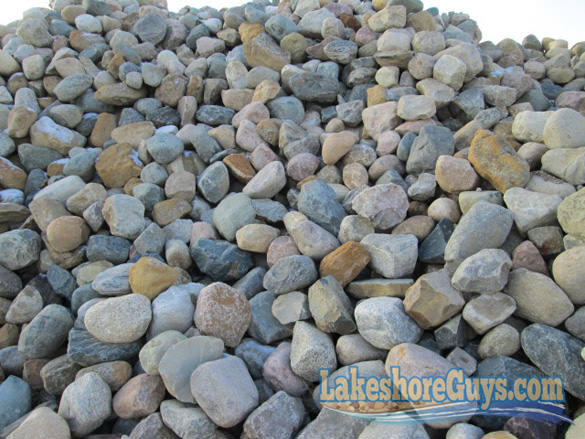
We won’t simply pile the rock a little higher on your shoreline. Rather, we’ll stretch your shoreline out a little more, both on the landward side and on the water-facing side. We’ll also add a little extra riprap here ‘n there, as needed.
Extra riprap on the water-facing side of the riprap (the toe) will help minimize the chances that your new riprap shoreline isn’t weakened by wave action. Wave action will slowly eat away at the lake bottom under your riprap (That’s a common problem with riprap shorelines where the riprap and fabric simply was not extended far enough into the water.)
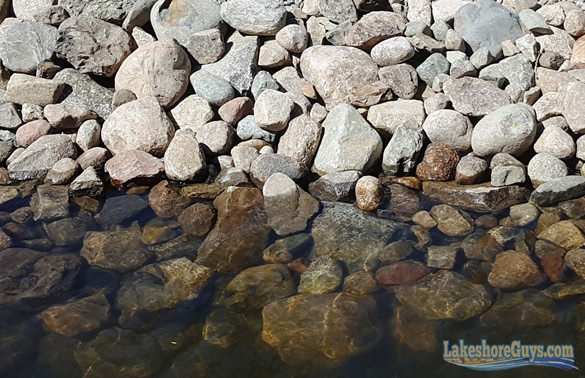
Extra riprap on the landward side of your shoreline (the heel) will help protect the top end of your riprap during periods of high water and/or extreme wave action.
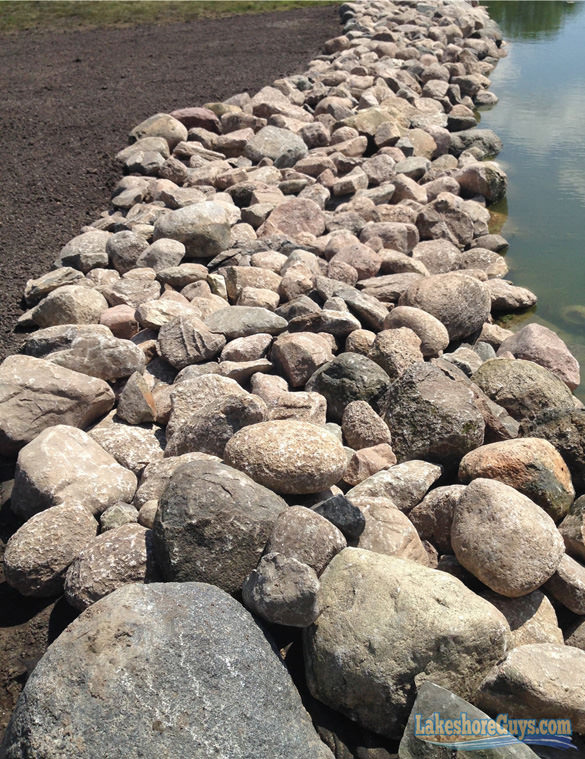
Extra riprap here ‘n there. There’s no trophy given to whomever installs the thickest pile of riprap along a shoreline. In fact, aside from thoroughly covering the fabric with a layer of riprap, too much riprap is almost always pointless. The purpose of riprap is simple: Aside from holding the fabric in place with downward pressure, dispersing the kinetic energy of waves, helping to deflect the movement of winter ice, riprap also helps protect the filter-fabric from deterioration caused by UV rays. Covering as much of the fabric as possible with riprap adds years to a riprapped shoreline.
Armored Shoreline Difference #12: Hand-Placed Riprap
Where most contractors simply pile on riprap with heavy equipment and smash it around with their giant steel bucket, we spend hours shuffling around hundreds of rocks by hand. This is hugely important for 5 reasons:
1. Aesthetics. Did Michelangelo paint the Sistine Chapel with a roller? Your new riprap shoreline will look divine only after we’ve moved around hundreds of rocks by hand.
First we perfect the row of riprap in the water. Then we make the row of riprap along the top edge of your shoreline perfect. Finally we take on the daunting job of moving around many hundreds of rocks in the center of your shoreline, filling everything in nicely.
It’s all to make your shoreline smooth and settled-looking.
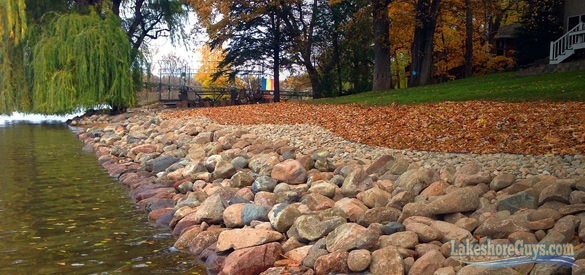
2. Covering the fabric. As we shuffle around many hundreds of rocks by hand, we pay close attention to any areas of exposed fabric, and we make sure to cover those areas with perfectly sized rocks. Again: riprap is the only material that protects your all-important fabric from harmful UV rays.
3. Covering Staples. We also pay close attention to any visible staples that can be seen through the face of the riprap. Any staple that can be seen through the riprap is covered with single piece of riprap placed squarely on top.
4. Creating a Flat & Smooth Surface. Through all this hand-placement of the riprap, we’re able to create a much smoother surface. Whereas most shorelines act as Velcro for weeds and water bottles and dead fish, our smooth shoreline will hold onto a minimum of that flotsam.
5. Locking your shoreline together as one. Shuffling riprap by hand lets us interlock your riprap together so that it hangs together as a cohesive whole when buffeted by extreme waves. Most shorelines are piles of riprap that are as armored as a yarn sweater, whereas a Lakeshore Guys® Armored Shoreline is tightly woven like Kevlar.
Armored Shoreline Difference #13: How We Transport
Transportation of riprap stones may seem like a minor concern, but it’s not so minor if your yard gets ripped up. Many of our clients have had their shorelines riprapped wrong – almost always by landscapers – but what really chapped them was the unnecessary damage done to their yards by the wheels of skid steers.
Because landscapers and other contractors are not riprap specialists, they use the same old equipment they use to haul everything else. The transport of riprap is an afterthought. The result is a mess that looks like a dragon gave birth in your yard.
Even if they replaced your grass without charging you, you’d still spend your summer nursing seed and sod that requires daily watering and fertilizing and so forth.
We riprap. Landscapers rip up.
“Cleaned up 20 years of neglect in a few days. Their equipment and finesse operating it quickly completed our project with minimal disturbance to our yard. Dedicated crew that worked hard through a day of steady rain. Joe is a true specialist and we loved his drone photographs. Their final walkthrough to make sure we were completely satisfied assures you of the quality of their work. Highly recommend The Lakeshore Guys® and are enjoying our new beautiful shoreline.” – Brenda Vatland (read full review and see Brenda’s shoreline)
How on earth can we haul 20+ tons of riprap across your turf, to your shoreline, and bring our 3.5-ton piece of equipment back, without turning your yard into a mud-wrestling ring?
Because we’ve got 6 different ways to transport riprap:
Transportation option 1: Our Avant760i 4×4 Articulating Loader
This machine cost us more than 3 landscapers make in a year, and we had to get it shipped in from Ylöjärvi, Finland. But that’s a small price to pay, considering the sole reason we invested in an Avant: it is the perfect way to transport riprap without damaging your yard (or doing minimal damage when compared to the alternative everyone else uses).
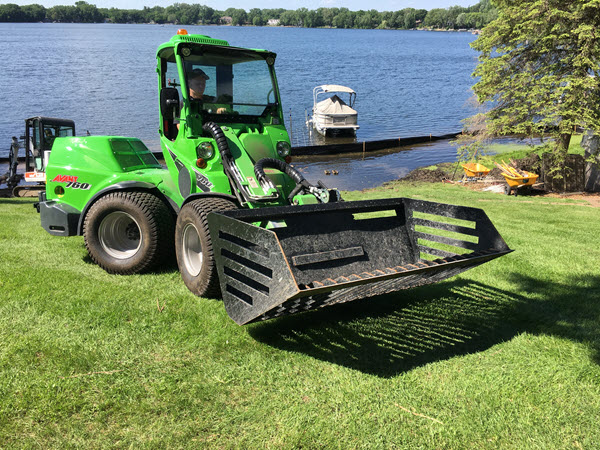
If you hire a landscaper or other contractor who uses tires, metal tracks, or even a designated rubber-tracked machine, you’ll spend thousands more dollars on repairing your yard and a hundred or so hours of your own time and labor maintaining the new seed or sod.
How is our Avant better than a landscaper’s skid-steer (Bobcat, Case, John Deere, Caterpillar, etc.)?
- It’s many thousands of pounds lighter than the average skid-steer.
- It lifts more, even though it’s lighter. Like a Nordic cross-country skier, it is lean and mean.
- It uses large turf tires rather than tracks or tires with aggressive treads, which means it actually turns rather “skids” when operated. (When you turn a tracked skid-steer or a skid-steer with tires, one side turns and the other side skids across the ground.)
- It articulates when turned, which eliminates all skidding and sliding, because all tires move at exactly the same speed. That also helps the Avant move onto tighter areas, because the rear tires follow the same path as the front tires do.
- The bucket (or whichever attachment is used) can hydraulically extend outwards, giving the Avant a much longer reach than a skid-steer, tractor, etc. Perfect for dumping riprap along the toe of a shoreline without having to drive atop the grade you just spent days perfecting.
- It’s faster than a skid-steer. The only thing less exciting than watching a landscaper’s Bobcat drag across your lawn is watching your replanted grass grow.
- It has more suspension than a skid-steer, because of its large balloon tires.
- It’s quieter.
- It uses less fuel, resulting in a smaller carbon footprint and less smog and smell around your property.
- The operator can see more in an Avant, making it safer. It’s also more comfortable. (Hey, even we might become gruff like landscapers if we sat in a Bobcat all day.)
- It doesn’t leave black rubber skid marks on your driveway because – again – there’s no skidding involved in its operation.
Transportation option 2: Smooth Rubber-Tracked Skid Loader
Though the Avant760i 4×4 Articulating Loader is our transport of choice, every now and then our T770 skid loader fills a need. When we do use it, we use our special, custom made, non-marking, smooth rubber flotation tracks whenever possible. These orange-colored tracks are special because it took us 24 years of questioning vendors and scouring the internet to find a company to produce them. Only our customers love them more than we do.
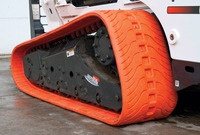
Since using this new setup (photographed above), we haven’t had more than a handful of yards that required anything more than a little topsoil and seed here-n’-there (and most didn’t require even that). These new smoothies (as we call them), don’t leave nearly as much of shoeprint on your yard. Because our machinery won’t leave Nike swooshes stamped all over your yard, there will be less damaged turf. Less replacement sod or seed will be required to repair the damage – on the off-chance there is any. That saves us time and saves you money.
Note: We also have an older Bobcat S185 (“Ol’ Trusty”) that we like to use from time to time, when it fills a need.
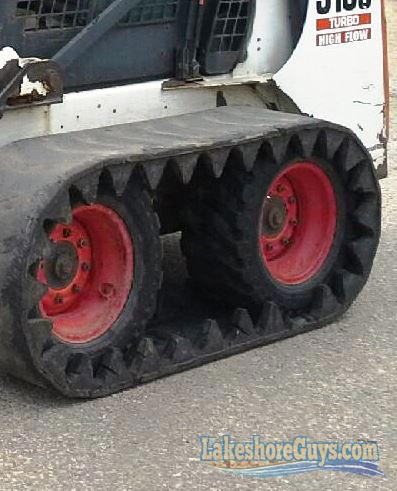
For this skid steer we hunt down heavily used rubber flotation tracks that no longer have any (or little) tread on them, making them smooth. The downfall is that because the tracks are near the end of their life, they’re stretched out, and because of that, they roll off the drive-wheels from time to time, requiring us to take few hours of work to reinstall them. But it’s worth the extra effort on our part to protect your yard.
Transportation option 3: Wheelbarrows.
As machine-savvy as we are, we’ve been known to wheelbarrow up to 30 tons of riprap back to a shoreline that didn’t allow us equipment access. My Lakeshore Guys® often have some colorful words for me when I ask them to do this, but it’s a small price to pay for saving your yard.
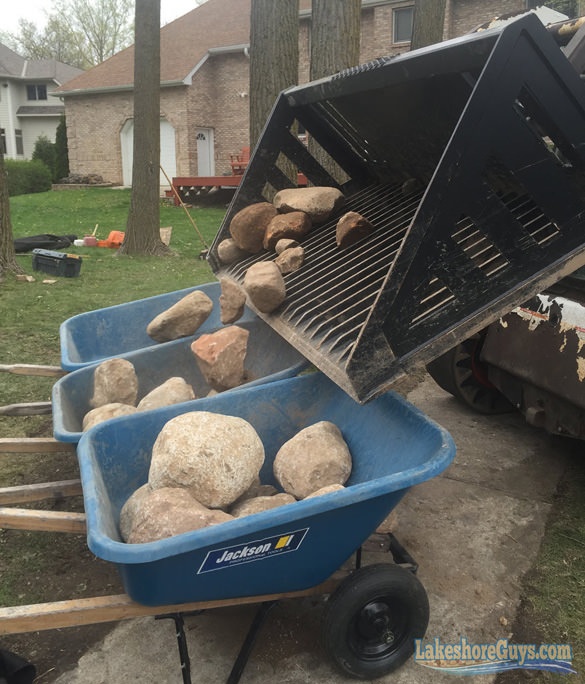
Transportation option 4: Construction chutes.
If you have a steep slope down to your shoreline, we can slide the riprap down a homemade construction chute. Usually we’ll transport the riprap as close to the shoreline as we can (using our smooth-rubber-tracked skid loader), and from there we’ll toss the riprap piece by piece into a large tube that extends down the hillside to the water’s edge. A lot of work, but it works.
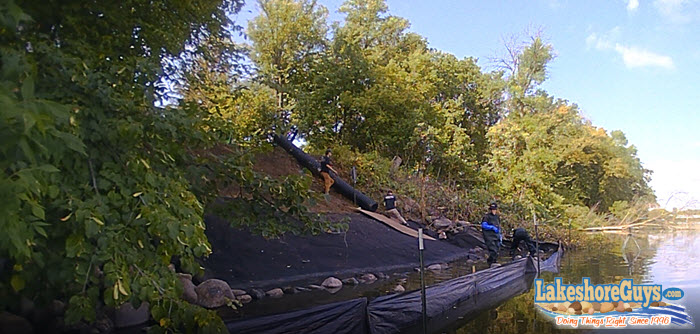
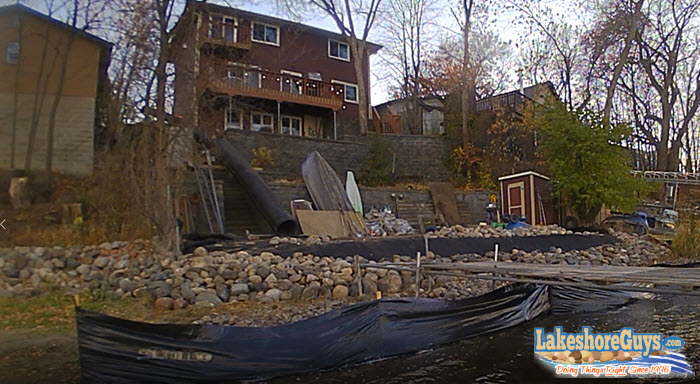
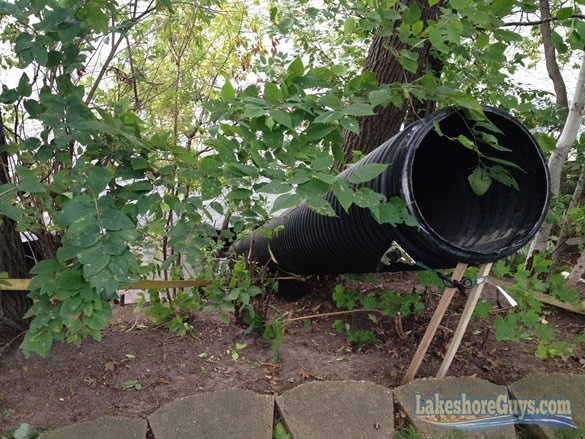
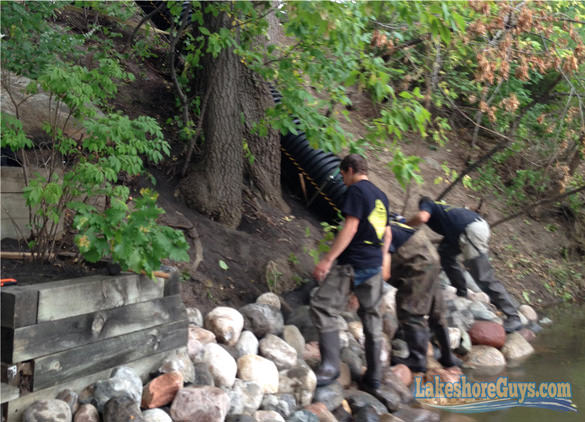
Transportation option 5: Five-gallon buckets.
In the last 20+ years there have only been two cases where we were forced to break out the trusty 5-gallon buckets. One was on a small job located in White Bear Lake, MN. On the other more memorable job, we hauled 12 tons of riprap down 3 flights of stairs to the Mighty Mississippi. The water was so deep along the the shoreline that we weren’t able to use the construction chute without losing our riprap in the deep waters. Again, when there’s a will, Lakeshore Guys® will find a way.
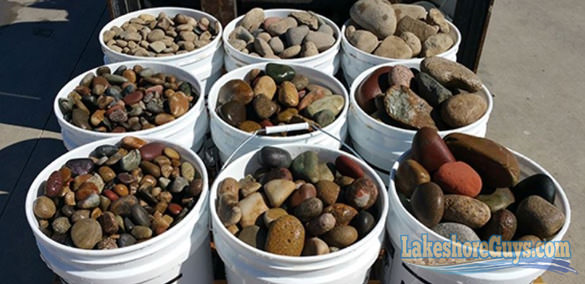
Transportation option 6: Barge
Once in a blue moon we’ll use a barge service to deliver our riprap from the water. Because of the cost, we rarely do this. That’s one reason. Also, you’d need to live on a mighty large body of water to accommodate a barge loaded with several tons of riprap.
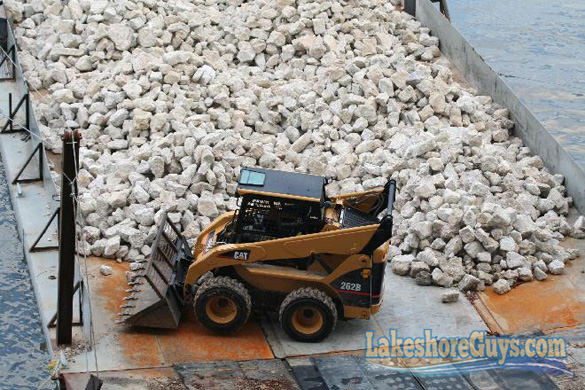
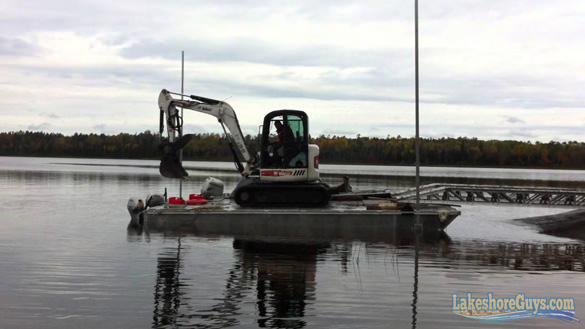
One thing we won’t do: we won’t bring riprap across the ice in the winter.
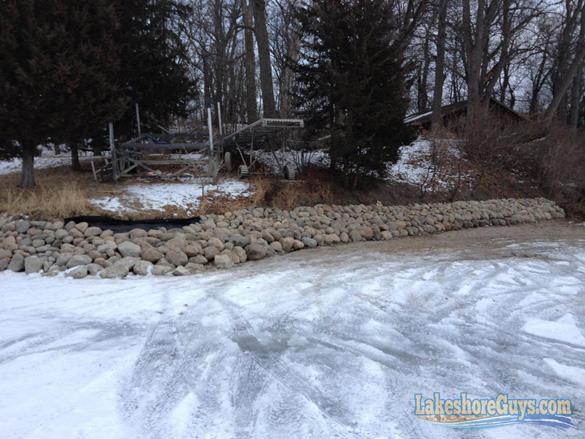
Remember, the most important parts of a shoreline are the grade and fabric. Any time you see a riprap shoreline being constructed during the winter, don’t admire their ingenuity. Pity is the more appropriate emotion.
Obviously, the ground can’t be graded when it’s frozen. Also, although we can lay out the fabric, we won’t be able to staple and secure it properly. Winter shoreline work is done by contractors who just need cash, and view your shoreline problems as your problems. (“Hey, nobody put a gun to their heads, they told us they wanted a shoreline this time of year….”)
Armored Shoreline Difference #14: Our Edging (optional)
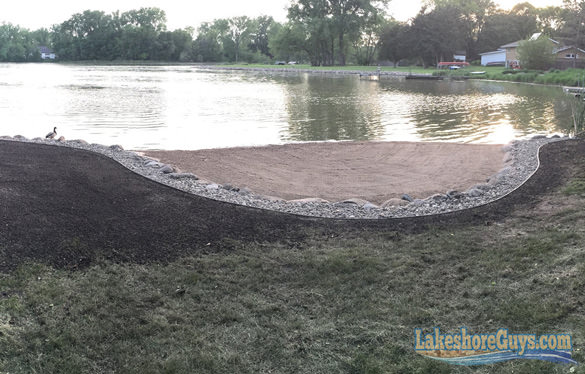
There’s nothing wrong with a simple riprap shoreline bordered only by grass or other natural turf. But we typically recommend it, and most of our customers want it. That’s because edging – made of concrete, brick, poly, or stone – brings a number of benefits:
Easy mowing and maintenance. When you have riprap right up against your turf, you’re left with the painstaking task of weed-whack all the grass in between the large rocks. Most people find this as pleasant as a root canal, so usually these areas go untended and your shoreline becomes an unkempt mess. Even if you do weed-whack the edge every weekend, you’ll create a layer of grass clippings that eventually decomposes and becomes soil. After a few years, your once-clean, weed-free sheet of filter-fabric becomes a garden of weeds, grass, and other plants you didn’t sign up for.
Now, imagine a nice border of edging approximately 1-2 feet wide, running alone the top edge of your riprapped shoreline. It’s a buffer between your riprap and your yard.
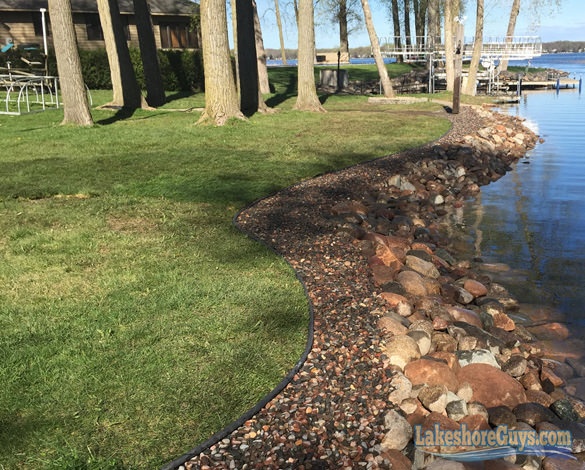
You’ll be able to run your mower deck right over the top of this edging and leave your weed-whacker in the garage. Also, if you keep your mower chute pointed away from your shoreline, you won’t have to worry about covering your shoreline with grass clippings (i.e. future compost).
Aesthetics. We haven’t met anyone who doesn’t like the look of crisp, clean edging that matches the riprap. Edging and decorative rock gives your shoreline the tailored, finished look it deserves. We can install commercial-grade poly edging, brick edging, concrete edging, and more.

Additional high-water and wave protection – AKA a “Splash Apron.” This thin strip of rock not only looks amazing, but also helps to protect your shoreline in the event of high water levels. Because we’ll use the same piece of filter-fabric under your decorative rock border that we used under your riprap, you’re getting that much more in flood protection. The higher the same solid piece of uncut fabric extends landward, the better your flood protection.
When installing your filter-fabric (prior to riprap installation), we will leave several feet of excess fabric near the top edge, running the entire length of your shoreline. After we’ve installed your riprap, we will install a border of edging along your entire shoreline. The next step is simply to unfold or unroll the excess filter-fabric along the top edge of your riprap so that it lies flat on the ground and covers the newly installed border of edging. At this point we will trim the fabric along the inside perimeter of your newly installed edging, and thoroughly staple it to the ground.
Now you’ve got riprap with fabric underneath it, and that same piece of fabric extends several feet up to the newly installed edging border. That combination provides added insurance against high water levels and heavy wave action. Remember, water that gets under the filter-fabric can cause erosion. The higher the fabric extends landward, the better your protection is.
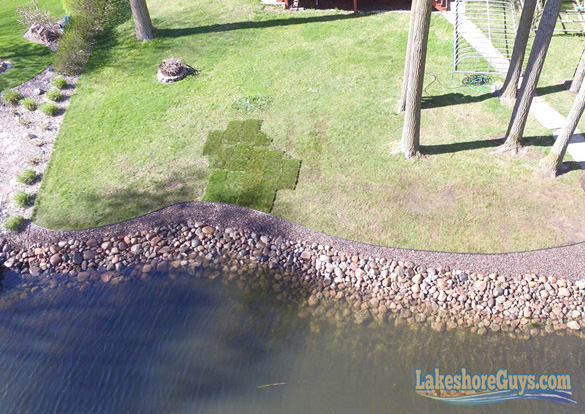
At this point your shoreline’s weakest point is the trimmed edge of the fabric adjacent to the edging border. Not to worry, though; read on.
Even more high water and wave protection. Instead of installing poly or individual bricks as edging, we can install one 5 x 7 continuously poured concrete curb along your entire shoreline.
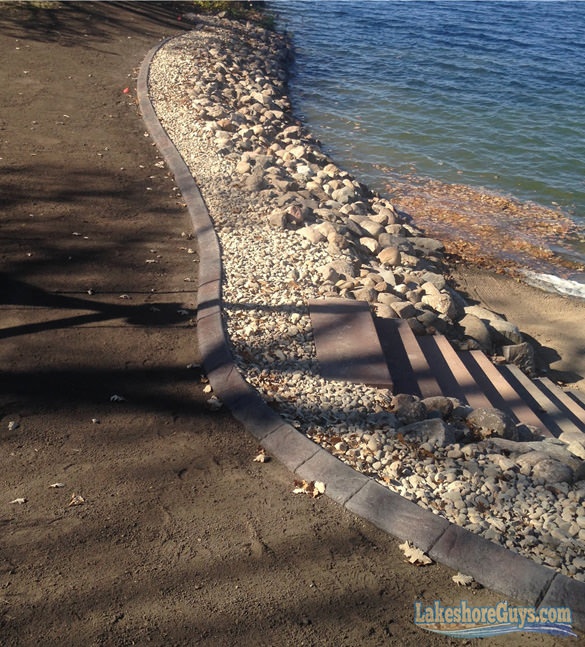
Rather than trimming the fabric up against the poly or brick edging, we’ll install this solid continuous concrete curbing directly onto the fabric. This virtually eliminates the ways water can seep get under the top edge of the filter-fabric along your shoreline. This curbing option will typically protect your shoreline even if it’s completely underwater.
Of course, Mother Nature will still do as she pleases. But with this curbing method your shoreline is far more likely to survive period of extremely high water – and it will look sharp.
All our curbing contains steel cable that runs through the entire center of the curb, as well as polymer and fiber additives for even greater strength. We can customize this concrete curbing in all kinds of ways: we can color it, hand-stamp it with a natural stone texture, and even incorporate LED lighting.
Armored Shoreline Difference #15: Frost-Break™
A Frost-Break™ is an option we can add to your new or existing riprap shoreline. It’s a way to protect your shoreline from ice heaving.
Imagine the riprap at an angle. It starts high on dry land and moves down the slope, where it extends about two feet into the water.
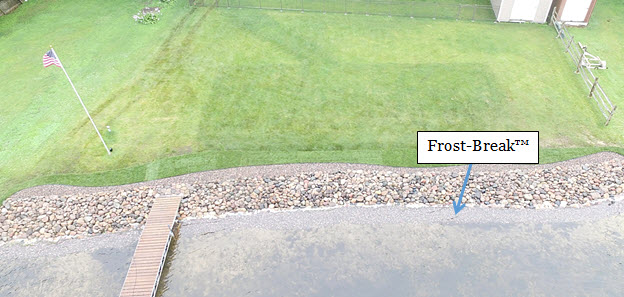
Example of Frost Break (TM) on a Lakeshore Guys® Shoreline
In the winter, the water freezes, and the riprap stones freeze in the water. They also freeze to the bottom of the lake.
The bottom of the lake is waterlogged. There’s water on it 24/7. So when the ice starts to jack – that is, to expand towards the shoreline – it’s not just the ice that comes charging toward your shoreline. It’s also the lake bottom. One giant mass, an icy bulldozer.
A Frost-Break™ is a swath of smaller river-rock that we place on the lake bottom directly in front of the riprap – in the water (the “toe” of your riprapped shoreline). This creates a buffer between the bottom of the ice sheet and the lake bottom (as well as a bit of separation from the riprap itself). When the ice starts to expand, the bond between the ice and the lake should break at the Frost-Break™ (the pile of small rock along the toe of your shoreline). We like to call this the “fault line.” It protects your shoreline and minimizes the chances of Mother Nature undoing all the work that’s gone into creating it.
Armored Shoreline Difference #16: Our Cleanup
“The guys were all very friendly, professional and courteous. Not only did they do beautiful work on our shoreline, but they took great care to minimize the damage to our yard from the heavy machinery. They laid down several plywood sheets to protect the ground and grass, they brought a pump that pumped lake water up to water the grass at the end of the day and they used a blower each night to fluff up the grass. They were also very tidy at the end of each day setting all of their equipment and supplies neatly in the driveway and the side of the yard- never left a mess over night!” – Heidi Lohn (read full review)
Our job-site cleanup and yard cleanup process is the stuff of legend among our customers. (They try to poach my Lakeshore Guys® crew and hire them as butlers, but I always nix the idea.) We pride ourselves on how clean and undamaged we leave your property.
We’ll cover any areas of unavoidably, lightly tousled turf with premium pulverized topsoil. We compact it a little, hand-rake it smooth, and spray it with a mixture of grass seed and mild fertilizer. Sometimes we’ll even dust the areas with a light coating of straw, which can aid in minimizing erosion and help moisture-retention.
Any areas of your yard that aren’t actually “damaged” but that show signs of wear from heavy foot traffic or wheelbarrow traffic will be thoroughly hand-raked, fluffed-up, and broadcasted with a mild fertilizer to help make it better than new.
The street side and driveway area we will thoroughly scrape, swept and leave as clean as possible upon completion. If we had to use your driveway for riprap storage or if we had to drive across it multiple times, there’s a good chance we may break out the garden hose and give it a quick bath. In some cases we’ve even been known to haul out our commercial grade hot-water pressure washer.
Anything we moved in your yard we will return to its original location. We leave everything the way we found it or better than we found it.
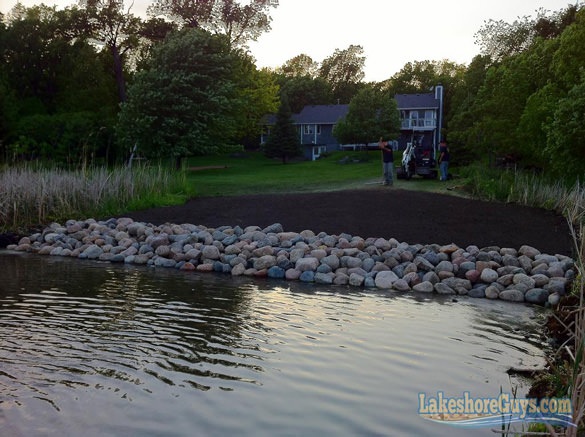
So there you have it. Unlike Colonel Sanders, we just revealed no fewer than 15 of our secret herbs and spices. But like the august Colonel, we do have even more techniques that we’ll need to keep a secret for now, other than to say that they’re also critical components of engineering a shoreline that holds up.
Could another company use our ingredients in a knockoff version of our Lakeshore Guys® Armored Shoreline? Yes, and in a strange way we’d be glad, because it’s nice to raise the bar for an industry.
But few or no other companies have the three intangibles that ultimately make Lakeshore Guys®‘ Armored Shoreline the best in show: our experience, passion, and attention to detail.
“I’ve been around a long time and have had lots of contractors do work for me but I’ve never seen this level of dedication to efficiency, coordination, keeping the work site tidy, and focus on getting the job done right….The RESULT: Our new shoreline looks fantastic! It was built to the highest standards both structurally and aesthetically. And, it’s become the talk of neighborhood.” – Ron Butterfield (read full review)
“The whole crew clearly took pride in their work and they were unfailingly courteous, friendly and professional.” – James Santelli (read full review and see James’s shoreline)
We’ve been building state-of-the-art shorelines for over 20 years. Although we’d love to describe our passion and attention to detail in as much depths as we just described our Armored Shorelines, we think those will be the first things you notice once we begin work on your property.
Of course, there’s no such thing as a “typical” Amored Shoreline. We offer a range of options and add-ons to fit your needs and vision, including:
Option: Muskrat-resistant shorelines
Option: Boat ramps
Option: Staircases and steps – down to your shoreline or even in your rirap shoreline
Option: Sand beaches
Other features and amenities – like patios, fire pits, and much more.
“It’s kind of tempting to invite them back, just to see what else they can do with the place.” – Joseph Hajtl (read full review and see Joseph’s shoreline)
Pick an Armored Shoreline for its unequaled toughness. Pick us, Lakeshore Guys®, to make your shoreline a family heirloom.


